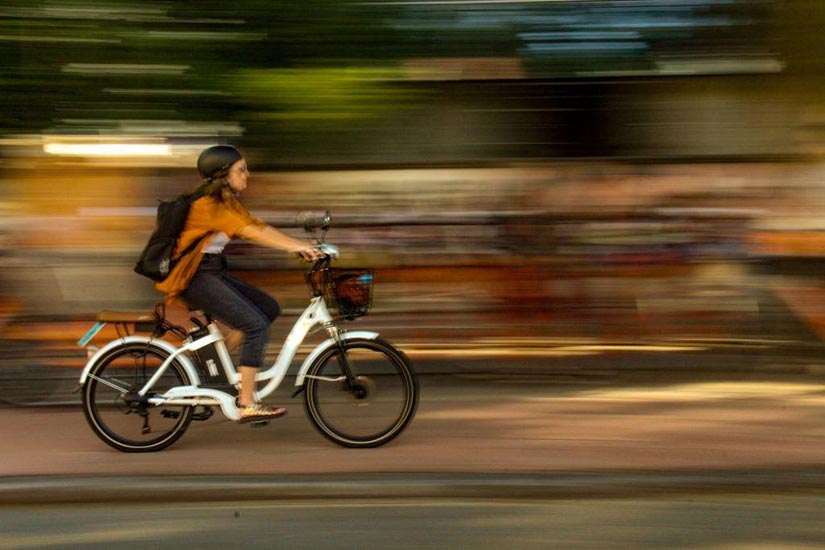Pilot Program Sheds Light on E-Bike Use Patterns, Energy-Efficiency Benefits
Analysis Shows E-Bikes Are an Effective, Energy-Saving Alternative to Other Travel Modes

The National Renewable Energy Laboratory (NREL) partnered with the Colorado Energy Office to assess the travel-behavior impacts of providing low-income essential workers with e-bikes during the COVID-19 pandemic. Analysis results indicate that, among participants during the study period, e-bikes were the dominant travel mode for 30% of trips, followed by shared rides at 29% and single-occupancy-vehicle trips at just 20%.
Launched in fall 2020, the Colorado Energy Office’s Can Do Colorado eBike mini-pilot was designed to encourage energy-efficient transportation during the pandemic and demonstrate that e-bikes are a safe, healthy, and convenient way to make essential trips, including commuting to work.
What is an e-bike?
Pedal-assist e-bikes use an electric motor and battery to help power the bike. The motor amplifies the power behind each pedal stroke, augmenting the energy you put into the bike.
"Riding an e-bike makes you feel superhuman," Duvall said. "With very little energy input, you can go far and fast."
“The onset of the COVID-19 pandemic dramatically reduced car travel, resulting in improved air quality and an opportunity to preview a cleaner mobility future,” said NREL’s Andy Duvall, a transportation behavior analyst. “Here at NREL, we wanted to determine how giving front-line workers an e-bike mobility option would affect their travel behavior, possibly contributing to a longer-term shift away from car dependence.”
The initial three-month pilot program provided e-bikes to 13 low-income essential workers in the Denver area. The insights garnered from this small-scale pilot—detailed in the resulting NREL technical report—are informing the design of the full-scale, two-year pilot slated to begin this summer in locations across Colorado.
Collecting and Assessing the Data
The data collection and integrated analysis elements of this project leveraged a smart-phone platform—e-mission—developed by K. Shankari, a director’s fellow in NREL’s Center for Integrated Mobility Sciences. Used to instrument human mobility, the free, open-source platform enables people to track their travel modes and measure their associated energy use and carbon footprint. Shankari customized the platform for the e-bike program, adding a gamification functionality to the collection of long-term travel-behavior data.
“Our analysis results indicate that the use of e-bikes corresponded to reduced travel time and increased productivity,” Shankari said. “Such end-to-end travel using a relatively fast yet inexpensive mode of transportation is very attractive. E-bikes also provide a very affordable entry into the burgeoning electric vehicle marketplace.”
“The e-bike program offers an important solution for affordable, efficient transportation. Such programs can go a long way toward supporting both equity and sustainability,” Shankari added.
Micromobility: Exploring an Avenue for Equity, Productivity, and Sustainability
Micromobility options, such as manual and electric-assisted human-powered vehicles, are often presented as a solution for reducing carbon emissions and improving energy efficiency for short-distance trips, especially in urban areas. Although transportation researchers have studied shared micromobility usage extensively, they have been unable to assess ownership micromobility characteristics due to the lack of relevant data. The data set generated via this project helps fill the gap while also informing the micromobility work that Duvall leads for the U.S. Department of Energy’s Systems and Modeling for Accelerated Research in Transportation Mobility Project.
“As far as I know, this is the only ownership model e-bike data-collection effort to date,” Duvall said. “The new data set reflects a longitudinal view of ownership micromobility, e-bike usage patterns, trip purpose, and the travel modes that the e-bike trips replaced. Unlike shared micromobility—where a third of the trips are used for accessing transit—ownership micromobility seems to be used more for end-to-end trips, like how cars are used.”
The pilot provided a baseline for understanding e-bike behavior, particularly as it pertains to personal ownership. It showed that e-bikes were primarily used to replace car trips, enabling participants to shift their mobility patterns toward cheaper, more sustainable choices, with energy and emissions benefits.
Learn more about NREL's sustainable transportation and mobility research and integrated data and analysis tools.
Last Updated May 28, 2025
